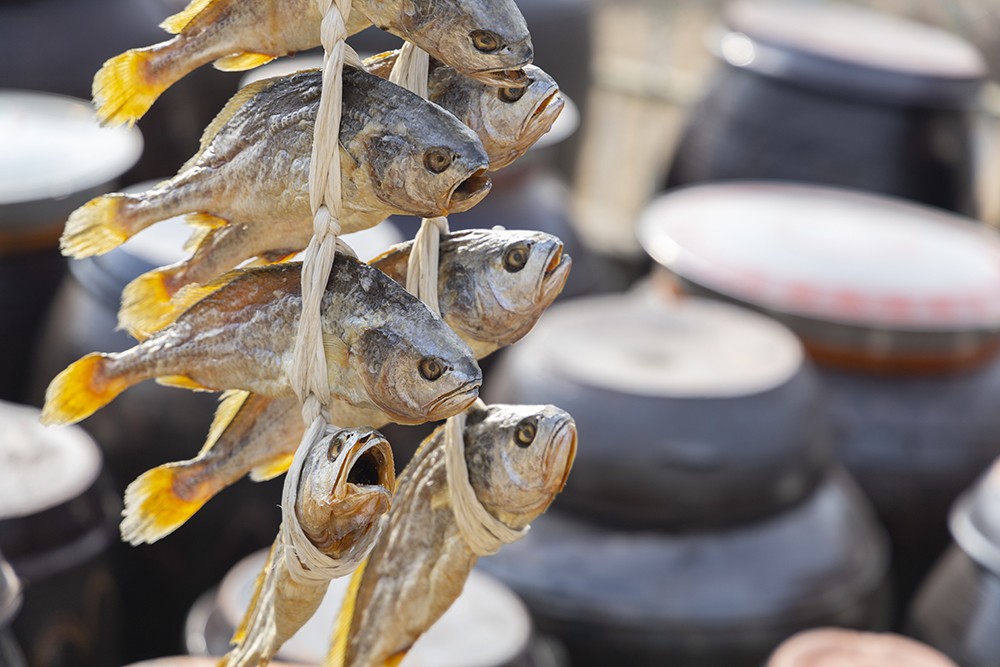한식 읽기 좋은 날
Vol 55. Flavors of HANSIK Enriched by the Wind
Three Wind-dried Gifts of the Ocean
The Tasteful Table
Raw fish plays an important role in Korean cuisine. Dried fish, however, is even more beloved because it is savory, chewy, and, most of all, able to be stored for very long periods of time thanks to its lack of moisture. Hwangtae, bakdae, and gulbi are Korean fish whose dried versions each offer a unique flavor and function.
Article Cha Yeji (Editorial Team) Source Doosan Encyclopedia

Dried by winter’s harshest winds: Hwangtae
Hwangtae is myeongtae (pollack) that has been dried through many cycles of freezing and thawing by winter winds at the coldest time of year. This causes the myeongtae’s flesh to become soft and take on a golden-yellow hue. Hwangtae is also called deodeok bugeo because it is pollack that is as dry as deodeok, a type of wild mountain root.
Because of its high protein content and almost complete lack of cholesterol, hwangtae is widely known as a health food. Its protein content is more than twice that of other well-known high-protein foods, such as eggs or chicken breast. It is also rich in methionine, a natural detoxifying agent that is helpful in improving liver function.
Due to all of these qualities, hwangtae is used in Korean cuisine primarily to make broth. A frequently-sought option is hwangtaehaejangguk (dried pollack hangover soup), which includes large pieces of boiled radish. Interestingly, shredded hwangtae (called hwangtaepo) is a favorite drinking snack, making pollack a companion of the entire “drinking cycle” in Korea. The fish is also popular as a side dish. Hwangtaegui, a grilled version that is coated with red pepper paste seasoning, and hwangtaejjim (steamed hwangtae) are the perfect companions for a bowl of rice.

Ⓒ Kim Jun (senior researcher, Gwangju Jeonnam Research Institute)
Chewy even after dried: Bakdae
Bakdae is a member of the fish order Pleuronectiformes that lives in Korea’s western and southern waters. It is well-liked by all ages for its firm flesh and lack of a strong “fishy” smell. Most bakdae sold at supermarkets or by retailers is half-dried by the winds of the western coast. The region that is most famous for the fish, however, is Gunsan, Jeollabuk-do Province.
Because it has little oil and is mild in taste, bakdae is a common diet food. Being high in iron makes it helpful in treating bone disorders such as osteoporosis, while its equally high levels of calcium make it a good ingredient for children and seniors. Half-dried bakdae, which could be stored for a long time, was a boon for pre-modern Koreans as a welcome source of nutrients during the winter.
Because its skin is quite tough, bakdae is almost always eaten half-dried and salted rather than fresh. Half-dried bakdae is known for its chewy, thick flesh. Also, because of its flat body (as a relative of the halibut), it is easy to grill. The flesh, which does not break apart easily, makes bakdae a good fish to braise in a spicy sauce made with red pepper flakes, gochujang (red chili paste), and soy sauce. Bakdae soup, which is mildly-seasoned and usually includes a lot of bean sprouts, is a delicacy that is made possible by the fish’s almost complete lack of unpleasant odors.

A delicious rice thief: Gulbi
Gulbi is the dried, salt-preserved version of yellow croaker (called jogi in Korean). Every Korean knows that Korea’s finest gulbi comes from Yeonggwang-gun, Jeollanam-do Province. Of the 13 types of yellow croaker available in Korea, the small yellow croaker (called chamjogi in Korean), as its name suggests, has a vertical yellow band on its belly. The small yellow croaker comes to Beopseongpo Port, which is near Yeonggwang-gun, to lay eggs: it is the fish caught this time of year that is turned into the famed “Yeonggwang gulbi.”
Gulbi was as highly-regarded in pre-modern Korea as it is today: it has a long history of use in ancestral rites, with gulbi from Yeonggwang having been served at the king’s table. Because Yeonggwang gulbi must be made with organic salt that has been stored for at least one year, in other cities, gulbi is made by submerging the fish in salt water and then taking it out and drying it. Of the many ways to make gulbi, one favorite involves drying the fish in the ocean breeze and then submerging it in salt water that contains whole barley grains. The barley absorbs much of the fish’s unpleasant odor.
Because it is rich in protein and vitamins A and D, gulbi is eaten to boost depleted energy levels. It is usually grilled and eaten on the spot but can also be steamed or braised. Less commonly (but no less delicious), the flesh from a dried gulbi is submerged in a gochujang-based seasoning.

 한국어
한국어
 English
English






